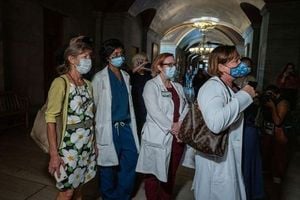As the federal government shutdown stretched into its fifth week in late October 2025, the effects rippled through communities across the United States, with Colorado emerging as a vivid microcosm of the broader crisis. While President Donald Trump's administration announced a $3 billion aid package for farmers, millions of Americans faced mounting uncertainty as critical social programs, business loans, and health subsidies teetered on the brink.
On October 22, 2025, Colorado Governor Jared Polis took a decisive step, formally requesting the state legislature’s Joint Budget Committee to allocate $10 million from the state’s General Fund. The goal: to keep the Supplemental Nutrition Assistance Program (SNAP) and the Women, Infants and Children (WIC) program afloat, at least through mid-December, if the federal impasse continued. According to Colorado Politics, both SNAP and WIC had been frozen as a direct result of the federal funding lapse, with the U.S. Department of Agriculture (USDA) warning that its funding for these lifelines would expire at the end of October. The consequences? About 42 million Americans could lose their benefits for November, including nearly 600,000 Coloradans—around 10% of the state’s population—who relied on SNAP in 2024.
"We are doing everything possible to ensure that vulnerable families do not go hungry because of this partisan gridlock," Polis said in a statement provided to Colorado Politics. The requested funds would support not only the federal programs but also local food banks and pantries, offering a temporary lifeline while Washington remained at a standstill.
The shutdown’s reach, however, extended far beyond food assistance. Colorado's schools, health clinics, small businesses, and veterans all felt the squeeze. The Department of Education’s Impact Aid Program, which provides crucial financial support to school districts located on federally owned land—like military bases and tribal communities—was suspended. According to the National Association of Federally Impacted Schools, Colorado typically receives about $50,000 in Impact Aid, split among 12 school districts. With these funds in limbo, educators and administrators faced tough choices about how to keep classrooms running smoothly.
Healthcare providers, too, were caught in the crosshairs. The expiration of the Community Health Center Fund on September 30 left Colorado’s 21 community health centers, which serve many uninsured and underinsured residents, scrambling to cover costs. The fund had previously provided about $111 million annually to these centers. As Colorado Politics reported, roughly 65% of the state’s community health centers were operating with negative margins—dipping into reserves, consolidating clinics, and laying off staff. In a novel move to keep some facilities afloat, state legislators had passed a bill permitting private donations to support federally qualified health centers, but the need remained acute.
Small businesses, often described as the backbone of the state’s economy, were not spared. The U.S. Small Business Administration (SBA) froze its two core loan programs—the 7(a) and 504 loans—leaving entrepreneurs in the lurch. According to the SBA, an average of 46 small business loans in Colorado were going unapproved each week, representing a loss of $26,000 in potential funding weekly. For many, these loans had been the difference between keeping the doors open and shutting down for good.
Even the state’s veterans, who had served their country with distinction, found themselves facing new hurdles. While most Veterans Affairs (VA) operations continued, some services—including career counseling and the GI Bill hotline—were paused. Regional VA offices, including the one in Denver, were temporarily closed, and outreach to community-based partners was suspended. For veterans seeking support as they transitioned to civilian life, these disruptions added another layer of anxiety.
The shutdown also cast a shadow over Colorado’s job market. With the Bureau of Labor and Statistics suspending all operations, the release of the monthly jobs report was delayed, depriving policymakers and businesses of the data they rely on to make informed decisions. The Colorado Department of Labor and Employment, which uses the federal data, was forced to operate in the dark, making it even harder to respond to shifting economic conditions.
Health insurance costs, already a source of stress for many families, threatened to surge higher. A key point of contention in Congress was the fate of enhanced tax subsidies for low-income Americans who purchase insurance through the individual marketplace. The enhanced credits, first introduced by the American Rescue Plan Act of 2021 and later extended by the Inflation Reduction Act of 2022, were set to expire in December 2025. Without renewal, Coloradans could see their insurance premiums jump by as much as 28%, with residents of the Western Slope potentially facing increases close to 40%, according to the Colorado Division of Insurance.
Meanwhile, Washington’s political stalemate showed few signs of breaking. House Speaker Mike Johnson, speaking to reporters on October 20, placed blame squarely on Democrats: "There’s nothing for us to negotiate. The House has done its job." Johnson insisted that Democrats needed to "stop the madness" and pass a stopgap spending bill that had already cleared the House. Yet with the House not expected to be in session that week, attention shifted to the Senate, where both parties continued to trade barbs but made little visible progress.
President Trump, for his part, was blunt when asked about the possibility of federal worker layoffs—a threat he had made repeatedly. "It’s taking place right now, and it’s all because of the Democrats," he told reporters on October 20, declining to specify which agencies were affected. The fear of layoffs only heightened tensions among federal employees and their families, many of whom had already missed paychecks.
Democratic leaders, meanwhile, insisted that renewing health insurance subsidies was essential to avoid a "crisis" for millions of Americans. House Democratic leader Hakeem Jeffries of New York lamented the lack of talks since a White House meeting on September 29, saying Republicans had "gone radio silent." Democratic Senator Adam Schiff of California warned that the expiration of enhanced subsidies would make insurance unaffordable for many, describing the situation as a looming "crisis."
Republicans countered that Democratic demands would lead to billions in health care spending for immigrants in the country illegally, a claim Democrats disputed. GOP leaders argued that the Democrats’ proposal would eliminate safeguards against waste, fraud, and abuse—costing taxpayers $200 billion—and open the door to expanded benefits for undocumented immigrants. They cited concerns about rolling back the Affordable Care Act’s "special rule" and what they dubbed the "California loophole."
Amid the finger-pointing and political theater, everyday Coloradans and millions of Americans elsewhere waited anxiously for relief. With federal programs stalled, state leaders like Governor Polis found themselves on the front lines, scrambling to fill the gaps. Whether Washington’s gridlock would break in time to prevent deeper hardship remained an open question, but for now, the shutdown’s real cost was being measured in lost meals, shuttered clinics, and mounting uncertainty across the country.




